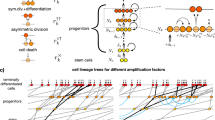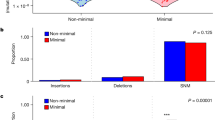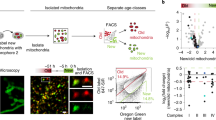Abstract
THE genetic mechanisms in differentiative phenomena of bacterial cells have recently been elucidated in great detail by the work of Jacob and Monod1–4. However, the differentiation of cells in multicellular organisms differs in some respects from that observed in bacterial cells. The main difference is in the virtual irreversibility of the differentiation observed in metazoan cells; for example, hepatocytes never change into neurones and vice versa. This type of differentiation, that assures stable cell diversities in multicellular organisms, is apparently lacking among bacterial cells. It seems necessary to recognize this peculiar feature of the metazoan cells before we discuss the genetic mechanisms of differentiation in this system. So we designate this phenomenon of stable specialization of cells as ‘major differentiation’ of metazoan cells. On the other hand, the differentiated metazoan cells also exhibit transient modulations both in functional and structural aspects; for example, hepatocytes, after hepatectomy, change their resting state, proliferate vigorously and, after complete restoration, re-attain their former highly differentiated state. This phenomenon has often been referred to as transient de-differentiation of hepatocytes. But it is not the same as the loss of major differentiation, as the former is a completely reversible phenomenon, like the reactions of bacteria to inducer or represser substances. This type of differentiation also includes functional changes of cells. We therefore distinguish it as ‘minor differentiation’. Thus, in metazoan cells we find at least two different types of differentiation, ‘major differentiation’, which is virtually irreversible and determines cell specificity in certain tissues, and ‘minor differentiation’, which is usually reversible and related rather to functional states of the cell. The cell usually shows both types of differentiation at the same time. Cells can lose or gain the minor differentiation without changing the state of major differentiation; hepato-cytes, for example, keeping their hepatocytic specificity unchanged, can be either in a resting functional state or in a proliferating regenerative phase. These peculiar features of major and minor differentiation are the outstanding characteristics that distinguish the differentiation of metazoan cells from that of bacterial cells. They must be taken into account in considering the genetic mechanisms involved in the differentiation of multicellular organisms.
This is a preview of subscription content, access via your institution
Access options
Subscribe to this journal
Receive 51 print issues and online access
$199.00 per year
only $3.90 per issue
Buy this article
- Purchase on Springer Link
- Instant access to full article PDF
Prices may be subject to local taxes which are calculated during checkout
Similar content being viewed by others
References
Jacob, F., and Monod, J., J. Mol. Biol., 2, 216 (1960).
Jacob, F., and Monod, J., J. Mol. Biol., 3, 318 (1961).
Monod, J., and Jacob, F., Cold Spr. Harb. Symp. Quant. Biol., 26, 389 (1961).
Monod, J., Changeux, J. P., and Jacob, F., J. Mol. Biol., 6, 306 (1963).
Fujita, S., and Takamoto, K., Nature, 200, 494 (1963).
Sonneborn, T. M., Proc. U.S. Nat. Acad. Sci., 51, 915 (1964).
Beermann, W., Cold Spr. Harb. Symp. Quant. Biol., 21, 217 (1956).
Beermann, W., Developmental Cytology (The Donald Press; New York, 1959).
Fujita, S., Proc. Japan. Soc. Histochem. (in the press).
Fujita, S., and Miyake, S., Symp. on Cellular Chemistry (Tokyo), 14, 275 (1964).
Pelling, C., Chromosoma, 15, 71 (1964).
Keyl, H. G., and Pelling, C., Chromasoma, 14, 347 (1963).
Plaut, W., J. Mol. Biol., 7, 632 (1963).
Uesu, M., Kaku, H., Kojima, A., and Fujita, A., Kagaku (Tokyo), 33, 596 (1963).
Taylor, J. H., J. Biophys. Biochem. Cytol., 1, 455 (1960).
Bonhoeffer, F., and Gierer, A., J. Mol. Biol., 7, 534 (1963).
Cairns, J., J. Mol. Biol., 6, 208 (1963).
Nagata, T., Proc. U.S. Nat. Acad. Sci., 49, 551 (1963).
Yoshikawa, H., and Sueoka, N., Proc. U.S. Nat. Acad. Sci., 49, 559 (1963).
Austin, C. R., and Amoroso, E. C., Exp. Cell Res., 13, 419 (1957).
Glenister, T. W., Nature, 117, 1135 (1956).
Park, W. W., J. Anat., 91, 369 (1957).
Barr, M., and Carr, D., Acta Cytol., 6, 34 (1962).
Grumbach, M. M., and Morishima, A., Acta Cytol., 6, 46 (1962).
Grumbach, M. M., Morishima, A., and Taylor, J. H., Proc. U.S. Nat. Acad. Sci., 49, 581 (1963).
Lyon, M. E., Nature, 190, 372 (1961).
Lyon, M. E., Amer. J. Genet., 14, 135 (1962).
Ohno, S., and Makino, S., Lancet, i, 78 (1961).
German, J., J. Cell. Biol., 20, 37 (1964).
Mukherjee, B. B., and Sinha, A. K., Proc. U.S. Nat. Acad. Sci., 51, 252 (1964).
Beutler, E., Yeh, M., and Fairbanks, V. F., Proc. U.S. Nat. Acad. Sci., 48, 9 (1962).
Grumbach, M. M., Marks, P. A., and Morishima, A., Lancet, i, 1330 (1962).
Hsu, T. C., Exp. Cell Res., 27, 332 (1962).
Russel, L. B., Science, 133, 1795 (1961).
Bender, M. A., and Prescott, D. M., Exp. Cell Res., 27, 221 (1962).
Kikuchi, Y., and Sandberg, A. A., J. Clin. Invest., 42, 947 (1963).
Moorhead, P. S., and Defendi, V., J. Cell Biol., 16, 202 (1963).
Stubblefield, E., and Mueller, G. C., Cancer Research, 22, 1091 (1962).
Author information
Authors and Affiliations
Rights and permissions
About this article
Cite this article
FUJITA, S. Chromosomal Organization as a Genetic Basis of Cytodifferentiation in Multicellular Organisms. Nature 206, 742–744 (1965). https://doi.org/10.1038/206742a0
Published:
Issue Date:
DOI: https://doi.org/10.1038/206742a0
This article is cited by
-
BUdR as an S-phase marker for quantitative studies of cytokinetic behaviour in the murine cerebral ventricular zone
Journal of Neurocytology (1992)
-
Chromomeres and puffing in experimentally induced polytene chromosomes ofCalliphora erythrocephala
Chromosoma (1979)
-
Proposals to the problem of structural and functional organization of polytene chromosomes
Theoretical and Applied Genetics (1974)
-
Asynchronous DNA Synthesis in a Duplicated Chromosomal Region of Drosophila melanogaster
Nature New Biology (1971)
-
Synthesis of Ribonucleic Acid by Human Chromosomes and a Possible Mechanism of its Repression
Nature (1966)
Comments
By submitting a comment you agree to abide by our Terms and Community Guidelines. If you find something abusive or that does not comply with our terms or guidelines please flag it as inappropriate.



